Professional Practice in Accounting: Budget Participation Analysis
VerifiedAdded on 2019/11/19
|14
|3172
|145
Report
AI Summary
This report delves into the realm of professional practice in accounting, commencing with a research plan focused on mobile advisory services, employing a qualitative approach to understand staff experiences. The study includes interviews with advisory staff members across multiple locations, focusing on their use of technology and the challenges encountered. The report also discusses the exploratory sequential design used in research, which combines qualitative and quantitative data collection methods. Furthermore, it analyzes several academic articles related to budget participation and its impact on employee performance within various sectors and cultural contexts, including Hofstede's cultural dimensions, specifically power distance and individualism. The report concludes by discussing how these concepts influence employee motivation and organizational performance, emphasizing the importance of employee involvement in the budgeting process and its alignment with cultural values.

Professional practice in accounting
Secure Best Marks with AI Grader
Need help grading? Try our AI Grader for instant feedback on your assignments.
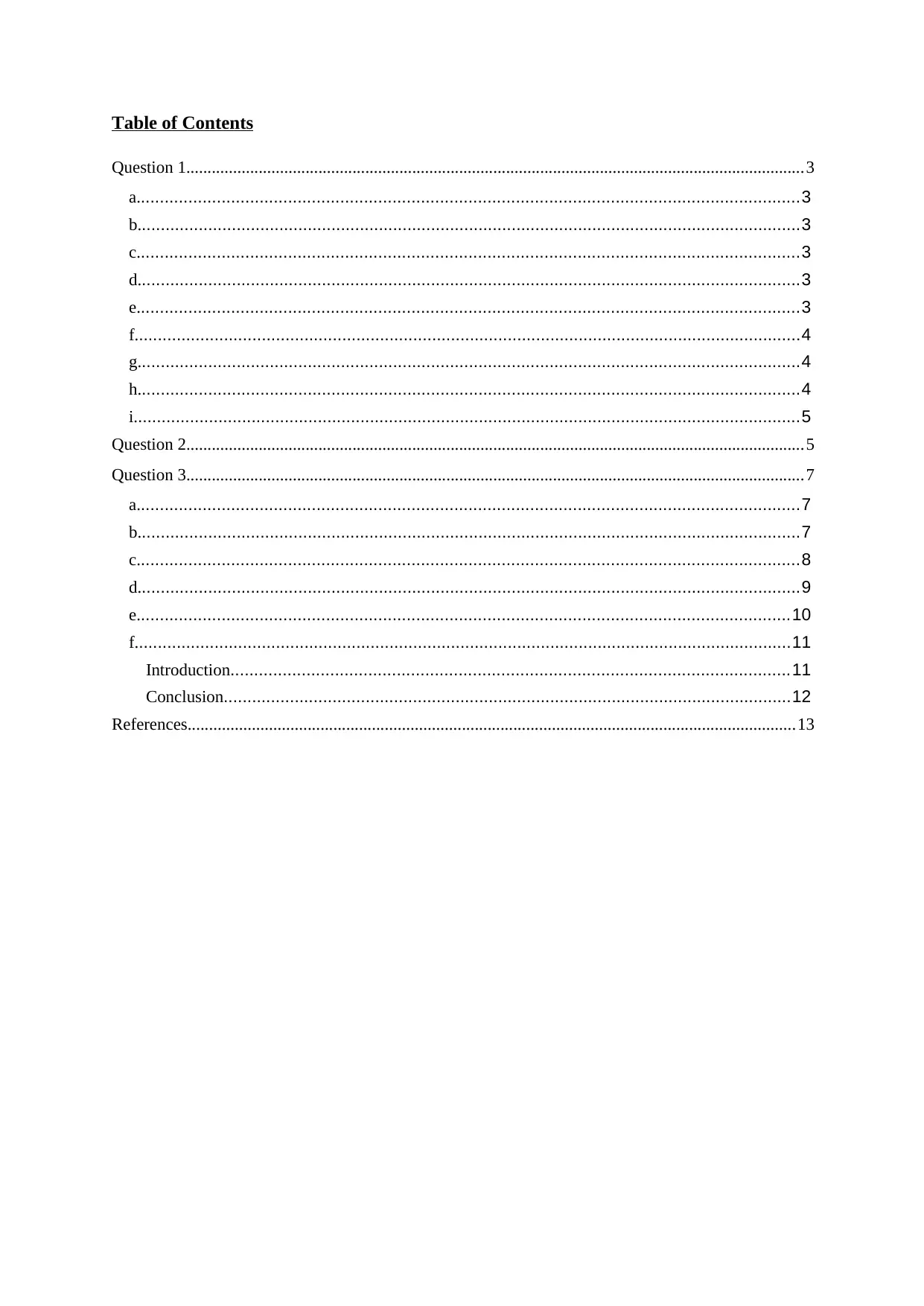
Table of Contents
Question 1.................................................................................................................................................3
a............................................................................................................................................3
b............................................................................................................................................3
c............................................................................................................................................3
d............................................................................................................................................3
e............................................................................................................................................3
f.............................................................................................................................................4
g............................................................................................................................................4
h............................................................................................................................................4
i.............................................................................................................................................5
Question 2.................................................................................................................................................5
Question 3.................................................................................................................................................7
a............................................................................................................................................7
b............................................................................................................................................7
c............................................................................................................................................8
d............................................................................................................................................9
e..........................................................................................................................................10
f...........................................................................................................................................11
Introduction......................................................................................................................11
Conclusion........................................................................................................................12
References..............................................................................................................................................13
Question 1.................................................................................................................................................3
a............................................................................................................................................3
b............................................................................................................................................3
c............................................................................................................................................3
d............................................................................................................................................3
e............................................................................................................................................3
f.............................................................................................................................................4
g............................................................................................................................................4
h............................................................................................................................................4
i.............................................................................................................................................5
Question 2.................................................................................................................................................5
Question 3.................................................................................................................................................7
a............................................................................................................................................7
b............................................................................................................................................7
c............................................................................................................................................8
d............................................................................................................................................9
e..........................................................................................................................................10
f...........................................................................................................................................11
Introduction......................................................................................................................11
Conclusion........................................................................................................................12
References..............................................................................................................................................13
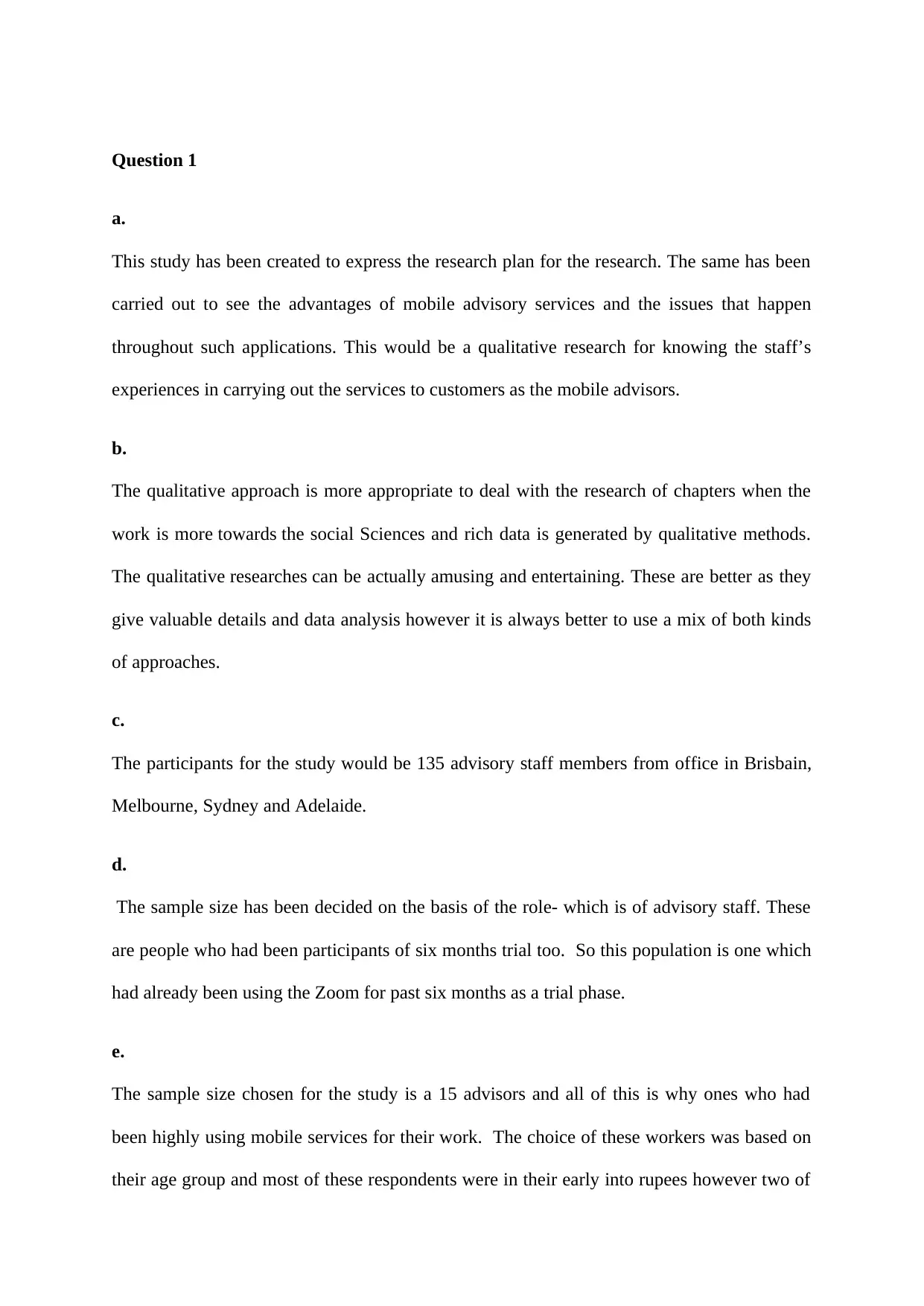
Question 1
a.
This study has been created to express the research plan for the research. The same has been
carried out to see the advantages of mobile advisory services and the issues that happen
throughout such applications. This would be a qualitative research for knowing the staff’s
experiences in carrying out the services to customers as the mobile advisors.
b.
The qualitative approach is more appropriate to deal with the research of chapters when the
work is more towards the social Sciences and rich data is generated by qualitative methods.
The qualitative researches can be actually amusing and entertaining. These are better as they
give valuable details and data analysis however it is always better to use a mix of both kinds
of approaches.
c.
The participants for the study would be 135 advisory staff members from office in Brisbain,
Melbourne, Sydney and Adelaide.
d.
The sample size has been decided on the basis of the role- which is of advisory staff. These
are people who had been participants of six months trial too. So this population is one which
had already been using the Zoom for past six months as a trial phase.
e.
The sample size chosen for the study is a 15 advisors and all of this is why ones who had
been highly using mobile services for their work. The choice of these workers was based on
their age group and most of these respondents were in their early into rupees however two of
a.
This study has been created to express the research plan for the research. The same has been
carried out to see the advantages of mobile advisory services and the issues that happen
throughout such applications. This would be a qualitative research for knowing the staff’s
experiences in carrying out the services to customers as the mobile advisors.
b.
The qualitative approach is more appropriate to deal with the research of chapters when the
work is more towards the social Sciences and rich data is generated by qualitative methods.
The qualitative researches can be actually amusing and entertaining. These are better as they
give valuable details and data analysis however it is always better to use a mix of both kinds
of approaches.
c.
The participants for the study would be 135 advisory staff members from office in Brisbain,
Melbourne, Sydney and Adelaide.
d.
The sample size has been decided on the basis of the role- which is of advisory staff. These
are people who had been participants of six months trial too. So this population is one which
had already been using the Zoom for past six months as a trial phase.
e.
The sample size chosen for the study is a 15 advisors and all of this is why ones who had
been highly using mobile services for their work. The choice of these workers was based on
their age group and most of these respondents were in their early into rupees however two of
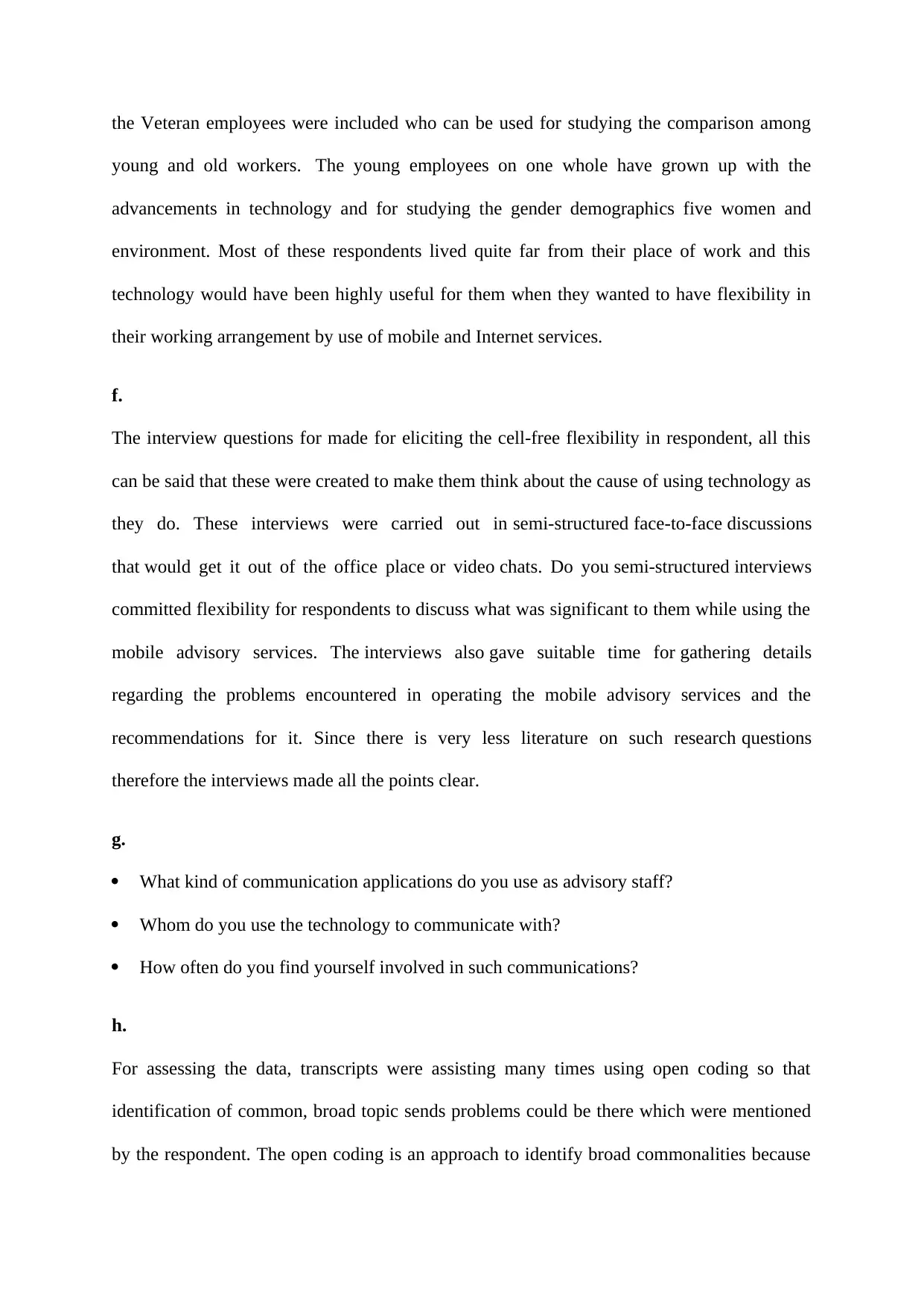
the Veteran employees were included who can be used for studying the comparison among
young and old workers. The young employees on one whole have grown up with the
advancements in technology and for studying the gender demographics five women and
environment. Most of these respondents lived quite far from their place of work and this
technology would have been highly useful for them when they wanted to have flexibility in
their working arrangement by use of mobile and Internet services.
f.
The interview questions for made for eliciting the cell-free flexibility in respondent, all this
can be said that these were created to make them think about the cause of using technology as
they do. These interviews were carried out in semi-structured face-to-face discussions
that would get it out of the office place or video chats. Do you semi-structured interviews
committed flexibility for respondents to discuss what was significant to them while using the
mobile advisory services. The interviews also gave suitable time for gathering details
regarding the problems encountered in operating the mobile advisory services and the
recommendations for it. Since there is very less literature on such research questions
therefore the interviews made all the points clear.
g.
What kind of communication applications do you use as advisory staff?
Whom do you use the technology to communicate with?
How often do you find yourself involved in such communications?
h.
For assessing the data, transcripts were assisting many times using open coding so that
identification of common, broad topic sends problems could be there which were mentioned
by the respondent. The open coding is an approach to identify broad commonalities because
young and old workers. The young employees on one whole have grown up with the
advancements in technology and for studying the gender demographics five women and
environment. Most of these respondents lived quite far from their place of work and this
technology would have been highly useful for them when they wanted to have flexibility in
their working arrangement by use of mobile and Internet services.
f.
The interview questions for made for eliciting the cell-free flexibility in respondent, all this
can be said that these were created to make them think about the cause of using technology as
they do. These interviews were carried out in semi-structured face-to-face discussions
that would get it out of the office place or video chats. Do you semi-structured interviews
committed flexibility for respondents to discuss what was significant to them while using the
mobile advisory services. The interviews also gave suitable time for gathering details
regarding the problems encountered in operating the mobile advisory services and the
recommendations for it. Since there is very less literature on such research questions
therefore the interviews made all the points clear.
g.
What kind of communication applications do you use as advisory staff?
Whom do you use the technology to communicate with?
How often do you find yourself involved in such communications?
h.
For assessing the data, transcripts were assisting many times using open coding so that
identification of common, broad topic sends problems could be there which were mentioned
by the respondent. The open coding is an approach to identify broad commonalities because
Secure Best Marks with AI Grader
Need help grading? Try our AI Grader for instant feedback on your assignments.

one is working comprehensively with the data by each line finding out about topics that
interesting. Then these broad themes were consolidated and there was exploration with focus
cording to find out the commonalities which were there in everybody's experience. Most of
the problems and experiences used for the study where are the commonalities shared by
majority of the respondents. In case the teams differed in present simple then different
explanations have to be getting it out to look for those findings.
i.
Limitations of the study would be that there is not defined way of dealing with any non-
related issues that might, come up while reviewing the data. One more limitation that has
been there was that there is very less literature available on this kind of study and lots of
research is needed to be carried out. The sample is also very small one drawn out from the
people who were put on trial and therefore there are several issues which are left
unaddressed.
Question 2
In exploratory sequential design the researcher initially gathers qualitative data and after
that quantitative data. The idea of an exploratory sequential mixed methods design includes
the process of primarily collecting qualitative data to investigate an incident and then
gathering quantitative data to give explanation of relations seen in the qualitative data
(Yunos, Sern and Hamdan, 2017).
The explanatory sequential design is more popular in the researchers. This design has primary
data collection of quantitative data and then getting the qualitative information for helping the
explanation or elaboration of quantitative outcomes. The main idea behind this method is that
the quantitative data and outcomes give a general view of the research issue, better analyses,
particularly by use of qualitative data gathering is required for refinement on explanation of
interesting. Then these broad themes were consolidated and there was exploration with focus
cording to find out the commonalities which were there in everybody's experience. Most of
the problems and experiences used for the study where are the commonalities shared by
majority of the respondents. In case the teams differed in present simple then different
explanations have to be getting it out to look for those findings.
i.
Limitations of the study would be that there is not defined way of dealing with any non-
related issues that might, come up while reviewing the data. One more limitation that has
been there was that there is very less literature available on this kind of study and lots of
research is needed to be carried out. The sample is also very small one drawn out from the
people who were put on trial and therefore there are several issues which are left
unaddressed.
Question 2
In exploratory sequential design the researcher initially gathers qualitative data and after
that quantitative data. The idea of an exploratory sequential mixed methods design includes
the process of primarily collecting qualitative data to investigate an incident and then
gathering quantitative data to give explanation of relations seen in the qualitative data
(Yunos, Sern and Hamdan, 2017).
The explanatory sequential design is more popular in the researchers. This design has primary
data collection of quantitative data and then getting the qualitative information for helping the
explanation or elaboration of quantitative outcomes. The main idea behind this method is that
the quantitative data and outcomes give a general view of the research issue, better analyses,
particularly by use of qualitative data gathering is required for refinement on explanation of

the general view (Yunos, Sern and Hamdan, 2017). This plan is primarily valuable when a
researcher has to create and examine a tool as one is not accessible or recognize significant
variables to find out quantitatively when the variables are unidentified. It is also suitable
when a researcher wishes to give a broad view outcome to diverse groups, to examine
features of a developing theory or categorization, or to investigate a phenomenon
exhaustively and then assess its occurrence.
researcher has to create and examine a tool as one is not accessible or recognize significant
variables to find out quantitatively when the variables are unidentified. It is also suitable
when a researcher wishes to give a broad view outcome to diverse groups, to examine
features of a developing theory or categorization, or to investigate a phenomenon
exhaustively and then assess its occurrence.
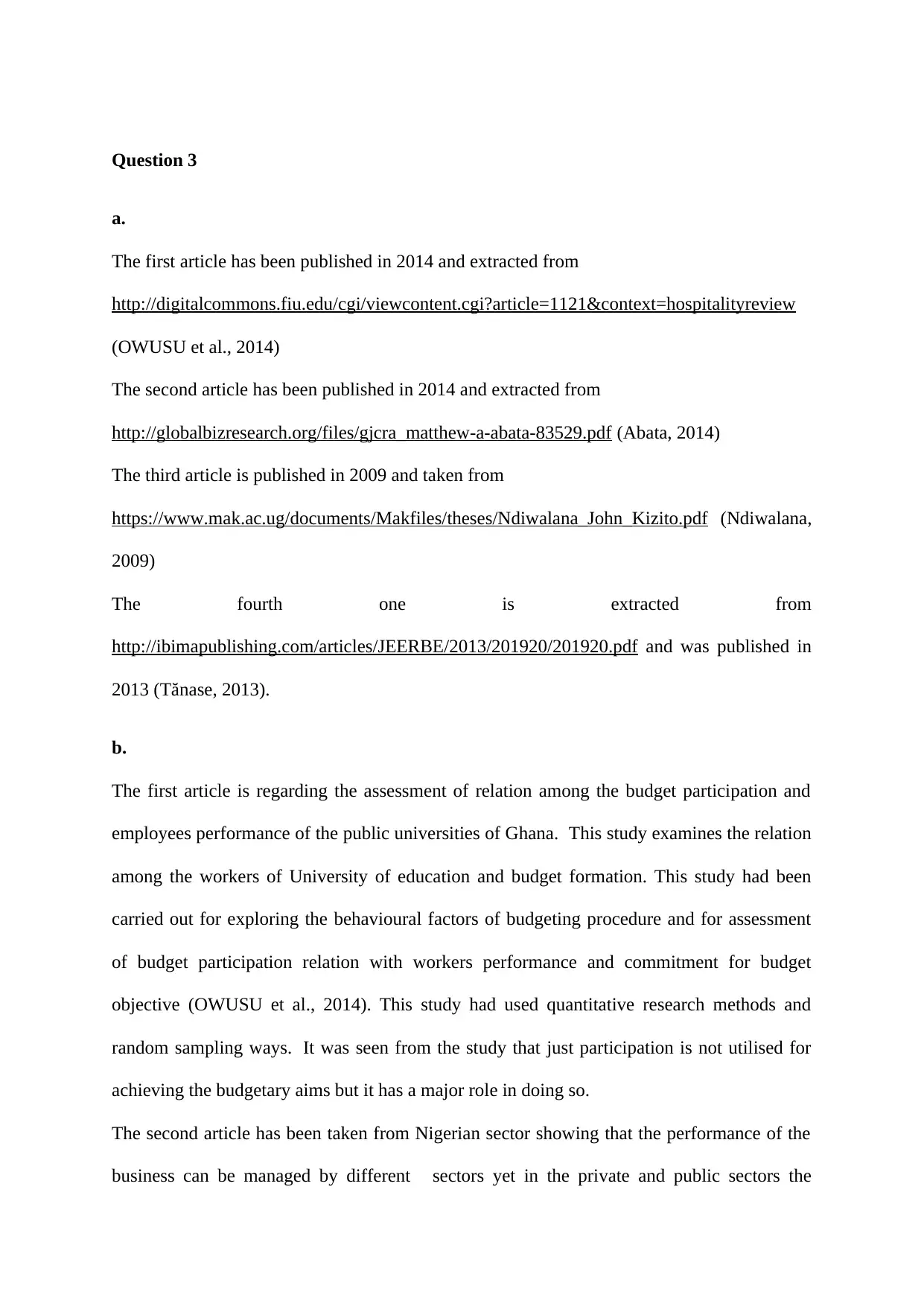
Question 3
a.
The first article has been published in 2014 and extracted from
http://digitalcommons.fiu.edu/cgi/viewcontent.cgi?article=1121&context=hospitalityreview
(OWUSU et al., 2014)
The second article has been published in 2014 and extracted from
http://globalbizresearch.org/files/gjcra_matthew-a-abata-83529.pdf (Abata, 2014)
The third article is published in 2009 and taken from
https://www.mak.ac.ug/documents/Makfiles/theses/Ndiwalana_John_Kizito.pdf (Ndiwalana,
2009)
The fourth one is extracted from
http://ibimapublishing.com/articles/JEERBE/2013/201920/201920.pdf and was published in
2013 (Tănase, 2013).
b.
The first article is regarding the assessment of relation among the budget participation and
employees performance of the public universities of Ghana. This study examines the relation
among the workers of University of education and budget formation. This study had been
carried out for exploring the behavioural factors of budgeting procedure and for assessment
of budget participation relation with workers performance and commitment for budget
objective (OWUSU et al., 2014). This study had used quantitative research methods and
random sampling ways. It was seen from the study that just participation is not utilised for
achieving the budgetary aims but it has a major role in doing so.
The second article has been taken from Nigerian sector showing that the performance of the
business can be managed by different sectors yet in the private and public sectors the
a.
The first article has been published in 2014 and extracted from
http://digitalcommons.fiu.edu/cgi/viewcontent.cgi?article=1121&context=hospitalityreview
(OWUSU et al., 2014)
The second article has been published in 2014 and extracted from
http://globalbizresearch.org/files/gjcra_matthew-a-abata-83529.pdf (Abata, 2014)
The third article is published in 2009 and taken from
https://www.mak.ac.ug/documents/Makfiles/theses/Ndiwalana_John_Kizito.pdf (Ndiwalana,
2009)
The fourth one is extracted from
http://ibimapublishing.com/articles/JEERBE/2013/201920/201920.pdf and was published in
2013 (Tănase, 2013).
b.
The first article is regarding the assessment of relation among the budget participation and
employees performance of the public universities of Ghana. This study examines the relation
among the workers of University of education and budget formation. This study had been
carried out for exploring the behavioural factors of budgeting procedure and for assessment
of budget participation relation with workers performance and commitment for budget
objective (OWUSU et al., 2014). This study had used quantitative research methods and
random sampling ways. It was seen from the study that just participation is not utilised for
achieving the budgetary aims but it has a major role in doing so.
The second article has been taken from Nigerian sector showing that the performance of the
business can be managed by different sectors yet in the private and public sectors the
Paraphrase This Document
Need a fresh take? Get an instant paraphrase of this document with our AI Paraphraser
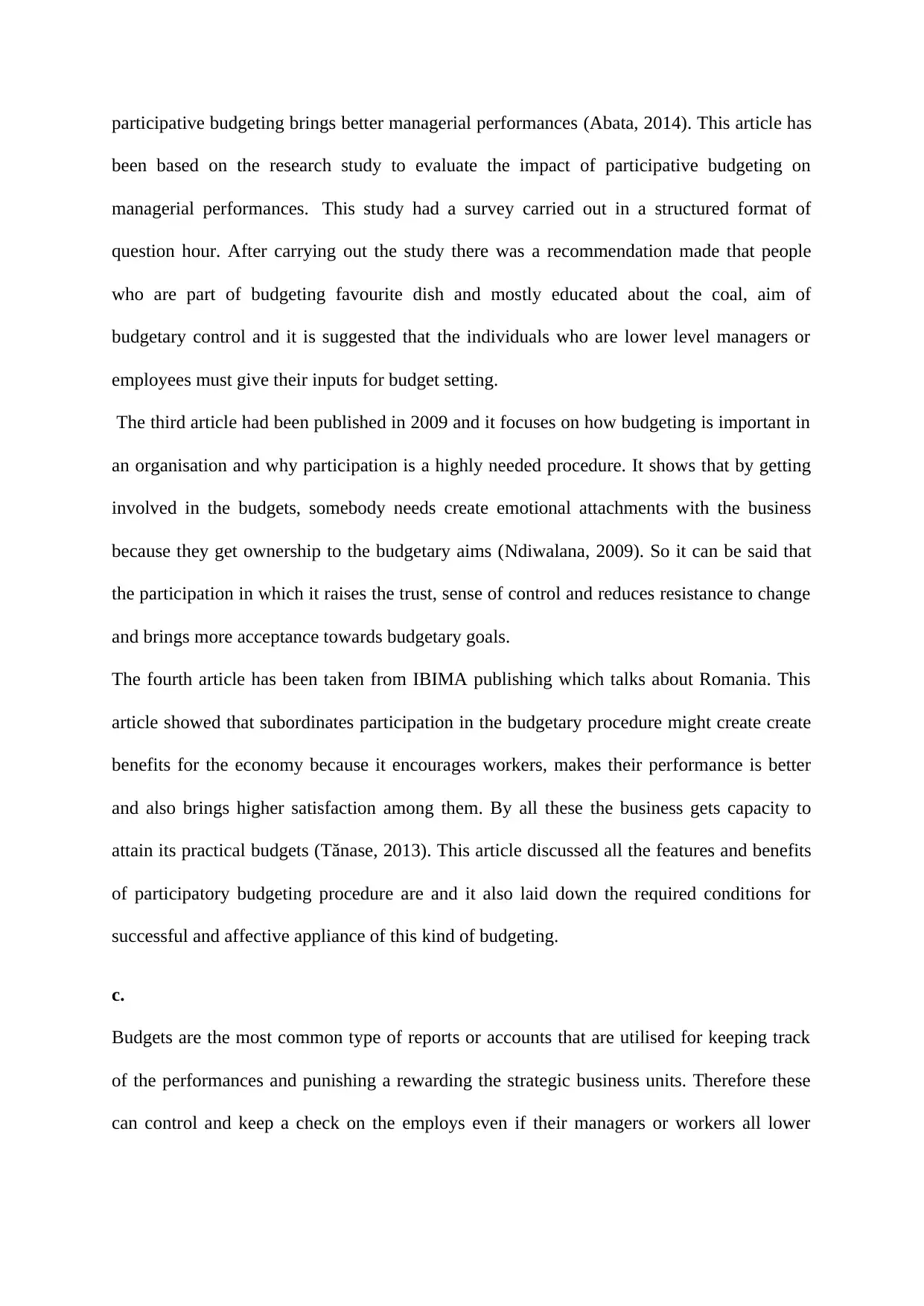
participative budgeting brings better managerial performances (Abata, 2014). This article has
been based on the research study to evaluate the impact of participative budgeting on
managerial performances. This study had a survey carried out in a structured format of
question hour. After carrying out the study there was a recommendation made that people
who are part of budgeting favourite dish and mostly educated about the coal, aim of
budgetary control and it is suggested that the individuals who are lower level managers or
employees must give their inputs for budget setting.
The third article had been published in 2009 and it focuses on how budgeting is important in
an organisation and why participation is a highly needed procedure. It shows that by getting
involved in the budgets, somebody needs create emotional attachments with the business
because they get ownership to the budgetary aims (Ndiwalana, 2009). So it can be said that
the participation in which it raises the trust, sense of control and reduces resistance to change
and brings more acceptance towards budgetary goals.
The fourth article has been taken from IBIMA publishing which talks about Romania. This
article showed that subordinates participation in the budgetary procedure might create create
benefits for the economy because it encourages workers, makes their performance is better
and also brings higher satisfaction among them. By all these the business gets capacity to
attain its practical budgets (Tănase, 2013). This article discussed all the features and benefits
of participatory budgeting procedure are and it also laid down the required conditions for
successful and affective appliance of this kind of budgeting.
c.
Budgets are the most common type of reports or accounts that are utilised for keeping track
of the performances and punishing a rewarding the strategic business units. Therefore these
can control and keep a check on the employs even if their managers or workers all lower
been based on the research study to evaluate the impact of participative budgeting on
managerial performances. This study had a survey carried out in a structured format of
question hour. After carrying out the study there was a recommendation made that people
who are part of budgeting favourite dish and mostly educated about the coal, aim of
budgetary control and it is suggested that the individuals who are lower level managers or
employees must give their inputs for budget setting.
The third article had been published in 2009 and it focuses on how budgeting is important in
an organisation and why participation is a highly needed procedure. It shows that by getting
involved in the budgets, somebody needs create emotional attachments with the business
because they get ownership to the budgetary aims (Ndiwalana, 2009). So it can be said that
the participation in which it raises the trust, sense of control and reduces resistance to change
and brings more acceptance towards budgetary goals.
The fourth article has been taken from IBIMA publishing which talks about Romania. This
article showed that subordinates participation in the budgetary procedure might create create
benefits for the economy because it encourages workers, makes their performance is better
and also brings higher satisfaction among them. By all these the business gets capacity to
attain its practical budgets (Tănase, 2013). This article discussed all the features and benefits
of participatory budgeting procedure are and it also laid down the required conditions for
successful and affective appliance of this kind of budgeting.
c.
Budgets are the most common type of reports or accounts that are utilised for keeping track
of the performances and punishing a rewarding the strategic business units. Therefore these
can control and keep a check on the employs even if their managers or workers all lower
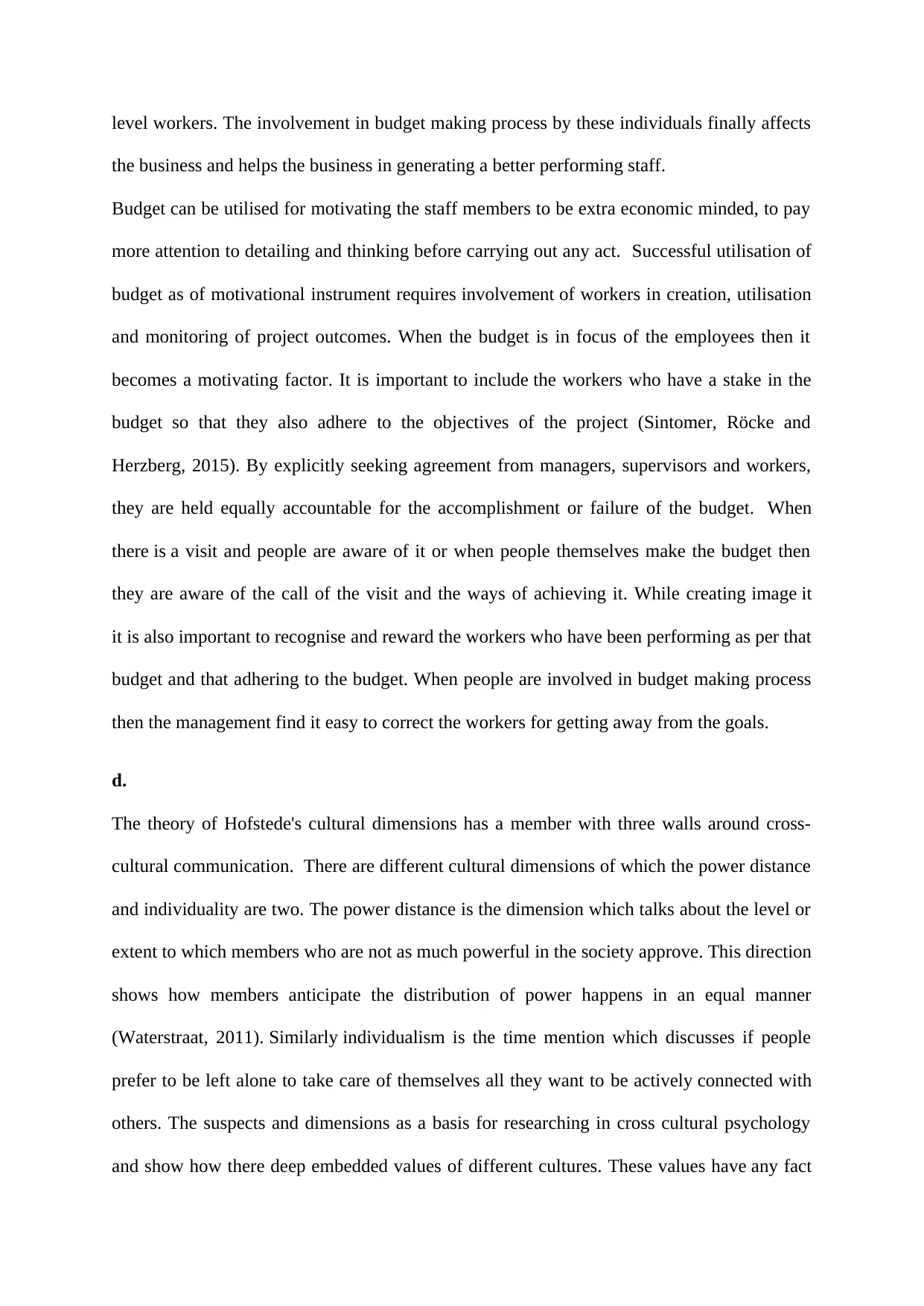
level workers. The involvement in budget making process by these individuals finally affects
the business and helps the business in generating a better performing staff.
Budget can be utilised for motivating the staff members to be extra economic minded, to pay
more attention to detailing and thinking before carrying out any act. Successful utilisation of
budget as of motivational instrument requires involvement of workers in creation, utilisation
and monitoring of project outcomes. When the budget is in focus of the employees then it
becomes a motivating factor. It is important to include the workers who have a stake in the
budget so that they also adhere to the objectives of the project (Sintomer, Röcke and
Herzberg, 2015). By explicitly seeking agreement from managers, supervisors and workers,
they are held equally accountable for the accomplishment or failure of the budget. When
there is a visit and people are aware of it or when people themselves make the budget then
they are aware of the call of the visit and the ways of achieving it. While creating image it
it is also important to recognise and reward the workers who have been performing as per that
budget and that adhering to the budget. When people are involved in budget making process
then the management find it easy to correct the workers for getting away from the goals.
d.
The theory of Hofstede's cultural dimensions has a member with three walls around cross-
cultural communication. There are different cultural dimensions of which the power distance
and individuality are two. The power distance is the dimension which talks about the level or
extent to which members who are not as much powerful in the society approve. This direction
shows how members anticipate the distribution of power happens in an equal manner
(Waterstraat, 2011). Similarly individualism is the time mention which discusses if people
prefer to be left alone to take care of themselves all they want to be actively connected with
others. The suspects and dimensions as a basis for researching in cross cultural psychology
and show how there deep embedded values of different cultures. These values have any fact
the business and helps the business in generating a better performing staff.
Budget can be utilised for motivating the staff members to be extra economic minded, to pay
more attention to detailing and thinking before carrying out any act. Successful utilisation of
budget as of motivational instrument requires involvement of workers in creation, utilisation
and monitoring of project outcomes. When the budget is in focus of the employees then it
becomes a motivating factor. It is important to include the workers who have a stake in the
budget so that they also adhere to the objectives of the project (Sintomer, Röcke and
Herzberg, 2015). By explicitly seeking agreement from managers, supervisors and workers,
they are held equally accountable for the accomplishment or failure of the budget. When
there is a visit and people are aware of it or when people themselves make the budget then
they are aware of the call of the visit and the ways of achieving it. While creating image it
it is also important to recognise and reward the workers who have been performing as per that
budget and that adhering to the budget. When people are involved in budget making process
then the management find it easy to correct the workers for getting away from the goals.
d.
The theory of Hofstede's cultural dimensions has a member with three walls around cross-
cultural communication. There are different cultural dimensions of which the power distance
and individuality are two. The power distance is the dimension which talks about the level or
extent to which members who are not as much powerful in the society approve. This direction
shows how members anticipate the distribution of power happens in an equal manner
(Waterstraat, 2011). Similarly individualism is the time mention which discusses if people
prefer to be left alone to take care of themselves all they want to be actively connected with
others. The suspects and dimensions as a basis for researching in cross cultural psychology
and show how there deep embedded values of different cultures. These values have any fact
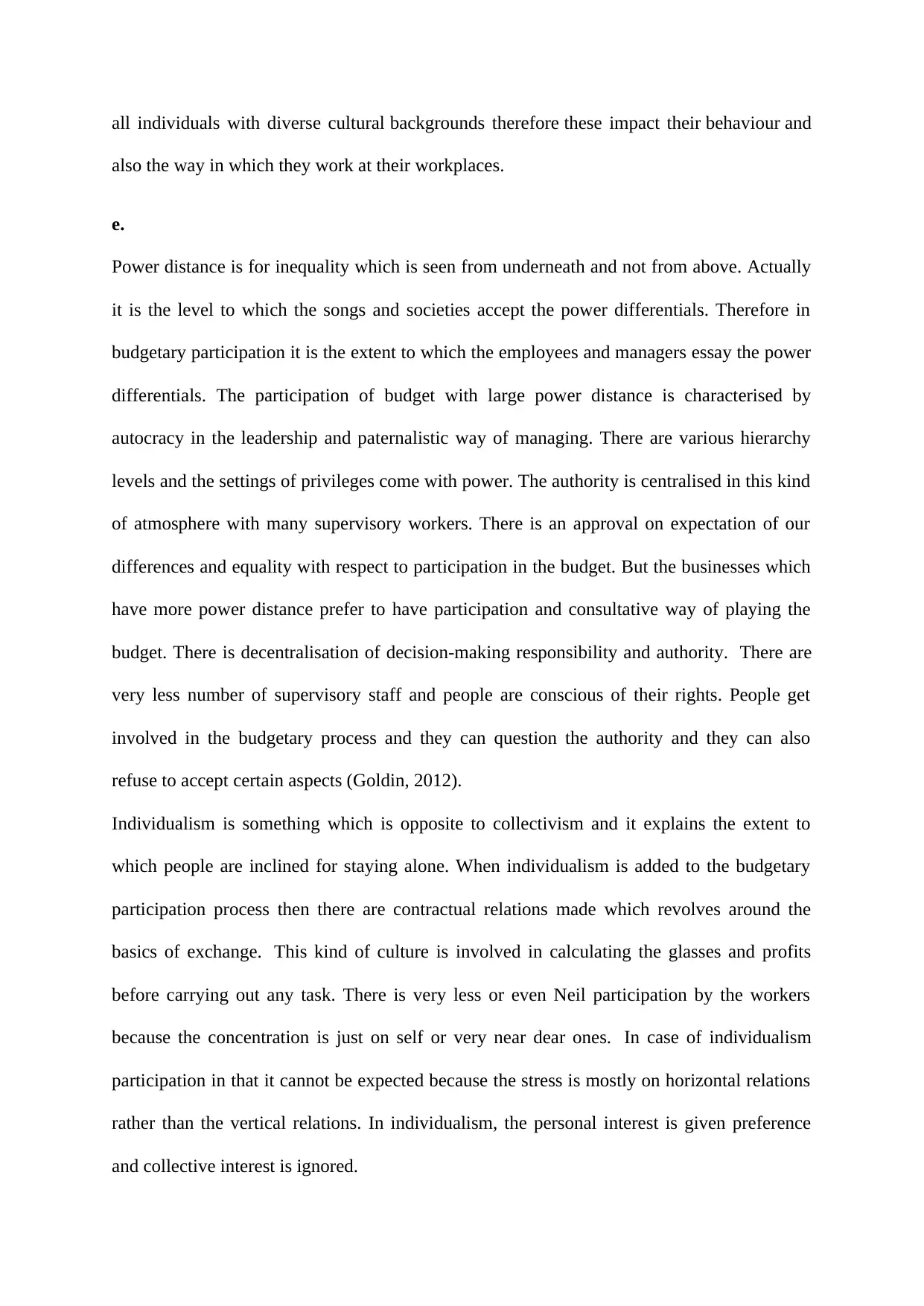
all individuals with diverse cultural backgrounds therefore these impact their behaviour and
also the way in which they work at their workplaces.
e.
Power distance is for inequality which is seen from underneath and not from above. Actually
it is the level to which the songs and societies accept the power differentials. Therefore in
budgetary participation it is the extent to which the employees and managers essay the power
differentials. The participation of budget with large power distance is characterised by
autocracy in the leadership and paternalistic way of managing. There are various hierarchy
levels and the settings of privileges come with power. The authority is centralised in this kind
of atmosphere with many supervisory workers. There is an approval on expectation of our
differences and equality with respect to participation in the budget. But the businesses which
have more power distance prefer to have participation and consultative way of playing the
budget. There is decentralisation of decision-making responsibility and authority. There are
very less number of supervisory staff and people are conscious of their rights. People get
involved in the budgetary process and they can question the authority and they can also
refuse to accept certain aspects (Goldin, 2012).
Individualism is something which is opposite to collectivism and it explains the extent to
which people are inclined for staying alone. When individualism is added to the budgetary
participation process then there are contractual relations made which revolves around the
basics of exchange. This kind of culture is involved in calculating the glasses and profits
before carrying out any task. There is very less or even Neil participation by the workers
because the concentration is just on self or very near dear ones. In case of individualism
participation in that it cannot be expected because the stress is mostly on horizontal relations
rather than the vertical relations. In individualism, the personal interest is given preference
and collective interest is ignored.
also the way in which they work at their workplaces.
e.
Power distance is for inequality which is seen from underneath and not from above. Actually
it is the level to which the songs and societies accept the power differentials. Therefore in
budgetary participation it is the extent to which the employees and managers essay the power
differentials. The participation of budget with large power distance is characterised by
autocracy in the leadership and paternalistic way of managing. There are various hierarchy
levels and the settings of privileges come with power. The authority is centralised in this kind
of atmosphere with many supervisory workers. There is an approval on expectation of our
differences and equality with respect to participation in the budget. But the businesses which
have more power distance prefer to have participation and consultative way of playing the
budget. There is decentralisation of decision-making responsibility and authority. There are
very less number of supervisory staff and people are conscious of their rights. People get
involved in the budgetary process and they can question the authority and they can also
refuse to accept certain aspects (Goldin, 2012).
Individualism is something which is opposite to collectivism and it explains the extent to
which people are inclined for staying alone. When individualism is added to the budgetary
participation process then there are contractual relations made which revolves around the
basics of exchange. This kind of culture is involved in calculating the glasses and profits
before carrying out any task. There is very less or even Neil participation by the workers
because the concentration is just on self or very near dear ones. In case of individualism
participation in that it cannot be expected because the stress is mostly on horizontal relations
rather than the vertical relations. In individualism, the personal interest is given preference
and collective interest is ignored.
Secure Best Marks with AI Grader
Need help grading? Try our AI Grader for instant feedback on your assignments.
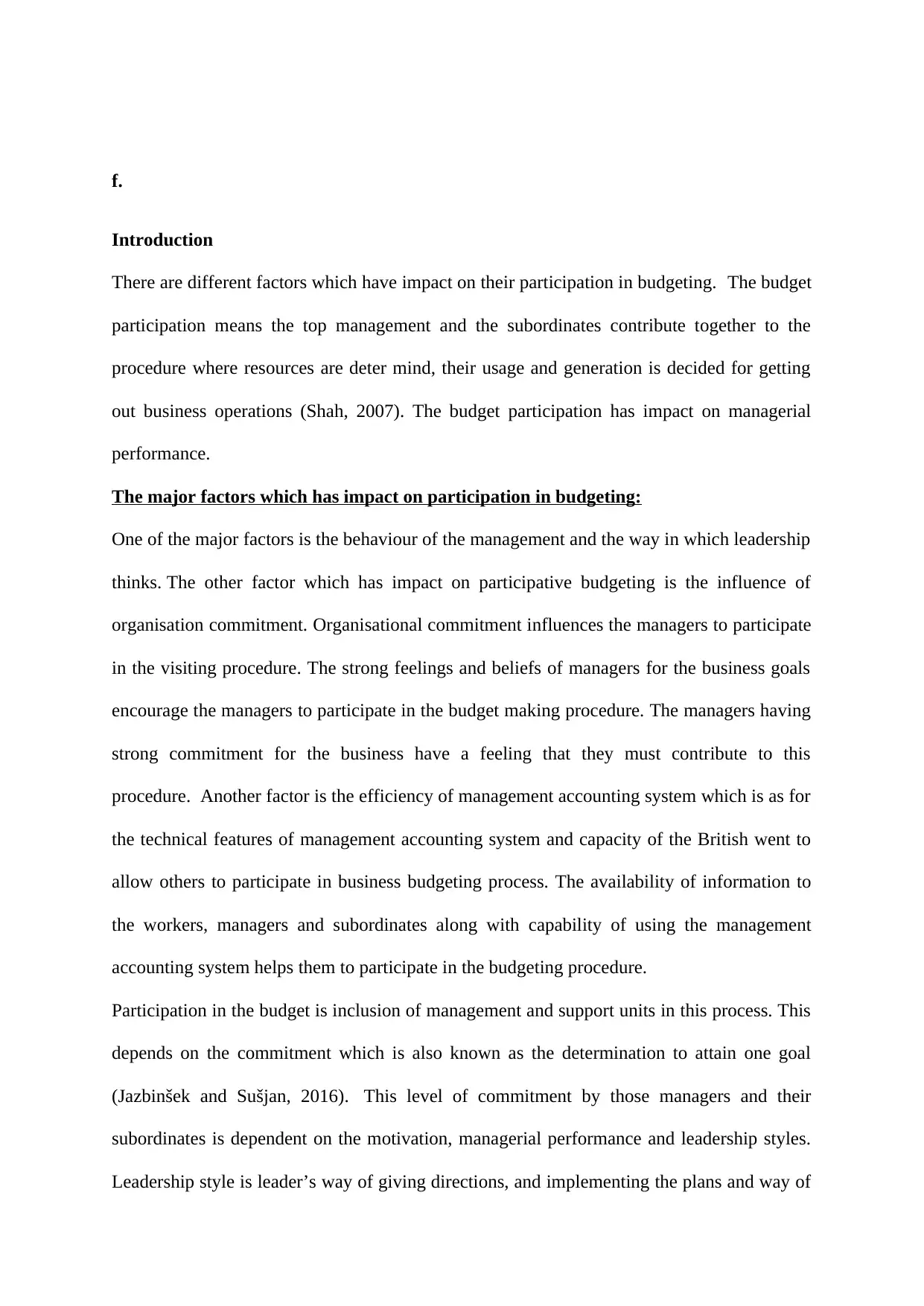
f.
Introduction
There are different factors which have impact on their participation in budgeting. The budget
participation means the top management and the subordinates contribute together to the
procedure where resources are deter mind, their usage and generation is decided for getting
out business operations (Shah, 2007). The budget participation has impact on managerial
performance.
The major factors which has impact on participation in budgeting:
One of the major factors is the behaviour of the management and the way in which leadership
thinks. The other factor which has impact on participative budgeting is the influence of
organisation commitment. Organisational commitment influences the managers to participate
in the visiting procedure. The strong feelings and beliefs of managers for the business goals
encourage the managers to participate in the budget making procedure. The managers having
strong commitment for the business have a feeling that they must contribute to this
procedure. Another factor is the efficiency of management accounting system which is as for
the technical features of management accounting system and capacity of the British went to
allow others to participate in business budgeting process. The availability of information to
the workers, managers and subordinates along with capability of using the management
accounting system helps them to participate in the budgeting procedure.
Participation in the budget is inclusion of management and support units in this process. This
depends on the commitment which is also known as the determination to attain one goal
(Jazbinšek and Sušjan, 2016). This level of commitment by those managers and their
subordinates is dependent on the motivation, managerial performance and leadership styles.
Leadership style is leader’s way of giving directions, and implementing the plans and way of
Introduction
There are different factors which have impact on their participation in budgeting. The budget
participation means the top management and the subordinates contribute together to the
procedure where resources are deter mind, their usage and generation is decided for getting
out business operations (Shah, 2007). The budget participation has impact on managerial
performance.
The major factors which has impact on participation in budgeting:
One of the major factors is the behaviour of the management and the way in which leadership
thinks. The other factor which has impact on participative budgeting is the influence of
organisation commitment. Organisational commitment influences the managers to participate
in the visiting procedure. The strong feelings and beliefs of managers for the business goals
encourage the managers to participate in the budget making procedure. The managers having
strong commitment for the business have a feeling that they must contribute to this
procedure. Another factor is the efficiency of management accounting system which is as for
the technical features of management accounting system and capacity of the British went to
allow others to participate in business budgeting process. The availability of information to
the workers, managers and subordinates along with capability of using the management
accounting system helps them to participate in the budgeting procedure.
Participation in the budget is inclusion of management and support units in this process. This
depends on the commitment which is also known as the determination to attain one goal
(Jazbinšek and Sušjan, 2016). This level of commitment by those managers and their
subordinates is dependent on the motivation, managerial performance and leadership styles.
Leadership style is leader’s way of giving directions, and implementing the plans and way of
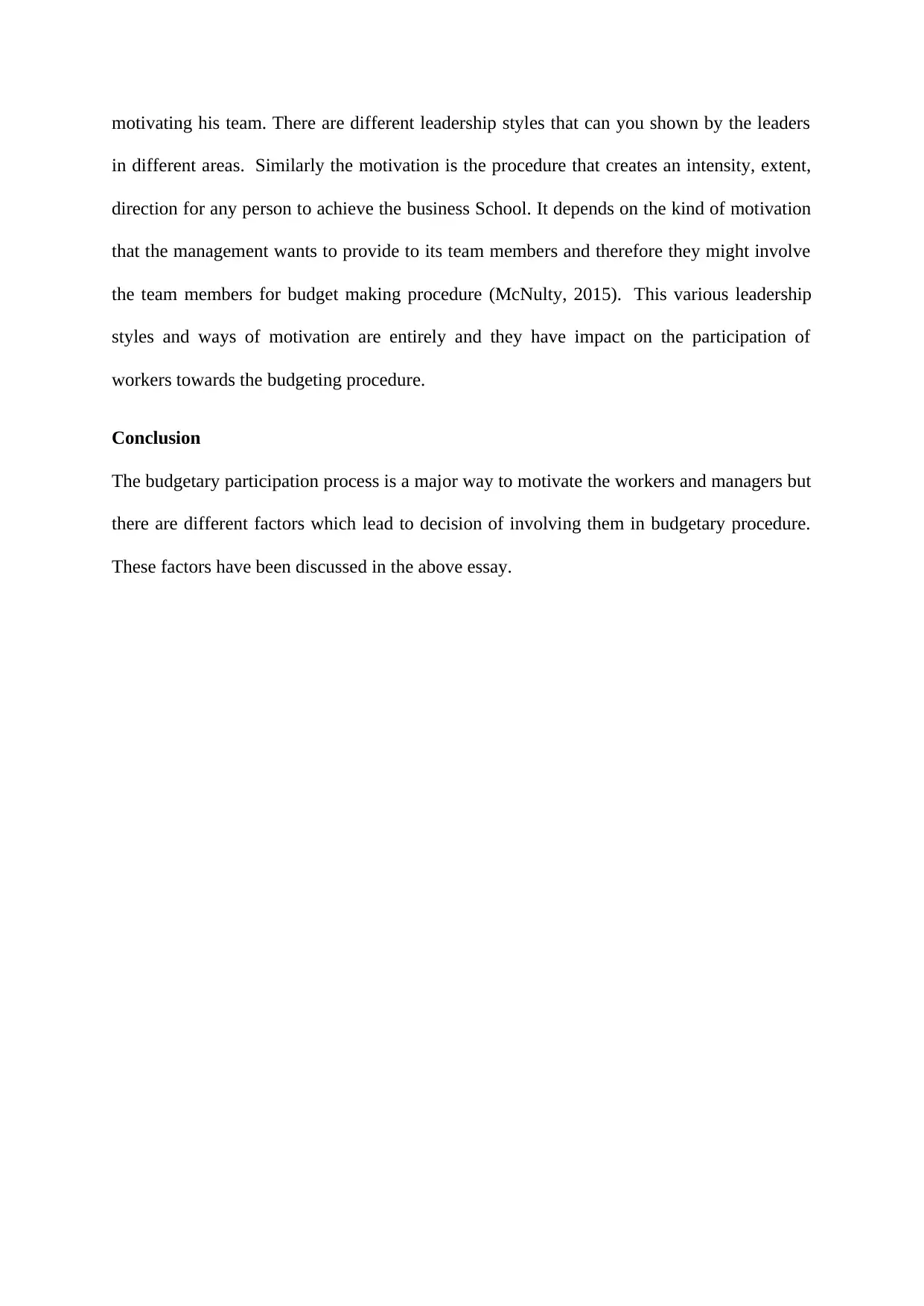
motivating his team. There are different leadership styles that can you shown by the leaders
in different areas. Similarly the motivation is the procedure that creates an intensity, extent,
direction for any person to achieve the business School. It depends on the kind of motivation
that the management wants to provide to its team members and therefore they might involve
the team members for budget making procedure (McNulty, 2015). This various leadership
styles and ways of motivation are entirely and they have impact on the participation of
workers towards the budgeting procedure.
Conclusion
The budgetary participation process is a major way to motivate the workers and managers but
there are different factors which lead to decision of involving them in budgetary procedure.
These factors have been discussed in the above essay.
in different areas. Similarly the motivation is the procedure that creates an intensity, extent,
direction for any person to achieve the business School. It depends on the kind of motivation
that the management wants to provide to its team members and therefore they might involve
the team members for budget making procedure (McNulty, 2015). This various leadership
styles and ways of motivation are entirely and they have impact on the participation of
workers towards the budgeting procedure.
Conclusion
The budgetary participation process is a major way to motivate the workers and managers but
there are different factors which lead to decision of involving them in budgetary procedure.
These factors have been discussed in the above essay.
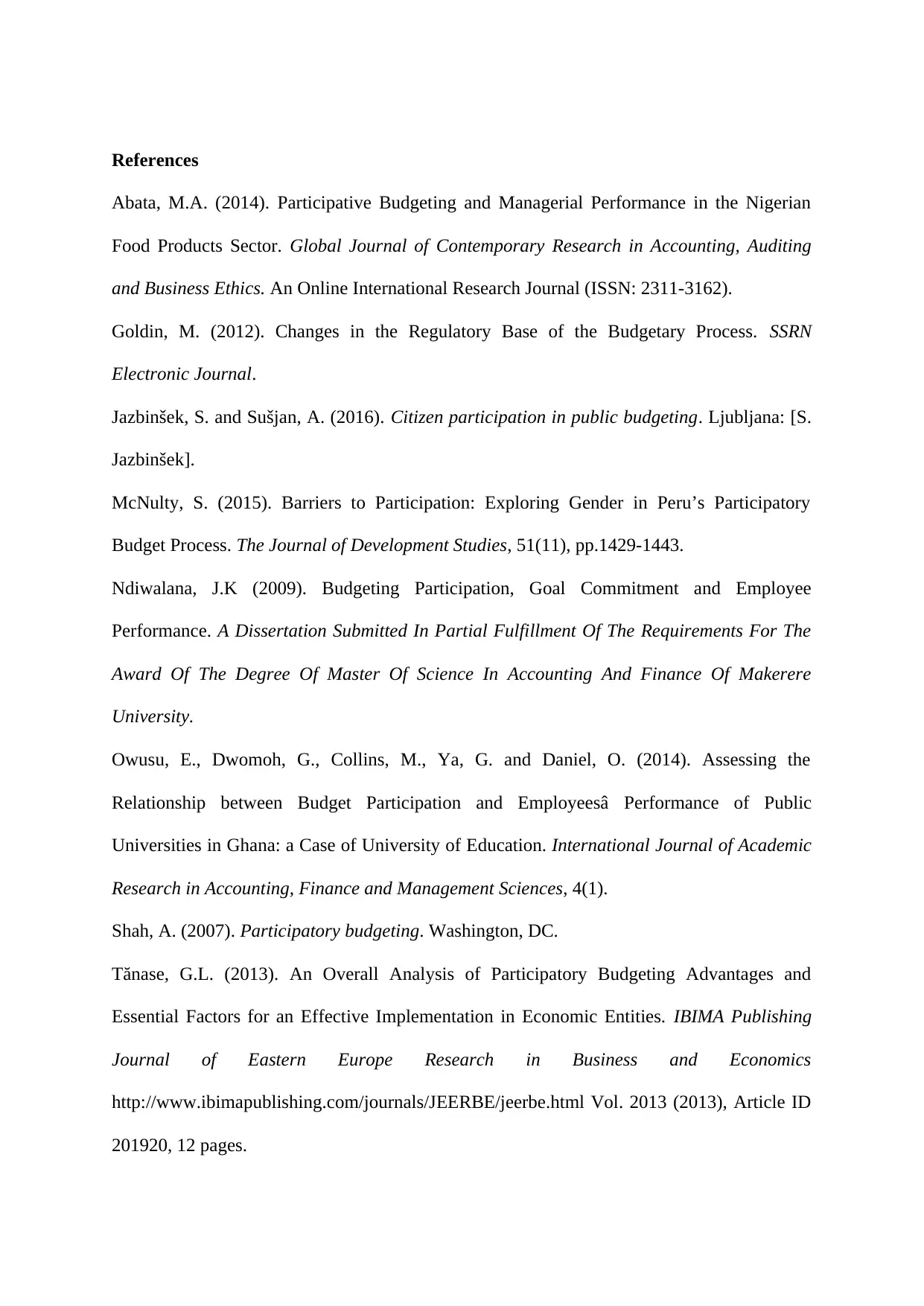
References
Abata, M.A. (2014). Participative Budgeting and Managerial Performance in the Nigerian
Food Products Sector. Global Journal of Contemporary Research in Accounting, Auditing
and Business Ethics. An Online International Research Journal (ISSN: 2311-3162).
Goldin, M. (2012). Changes in the Regulatory Base of the Budgetary Process. SSRN
Electronic Journal.
Jazbinšek, S. and Sušjan, A. (2016). Citizen participation in public budgeting. Ljubljana: [S.
Jazbinšek].
McNulty, S. (2015). Barriers to Participation: Exploring Gender in Peru’s Participatory
Budget Process. The Journal of Development Studies, 51(11), pp.1429-1443.
Ndiwalana, J.K (2009). Budgeting Participation, Goal Commitment and Employee
Performance. A Dissertation Submitted In Partial Fulfillment Of The Requirements For The
Award Of The Degree Of Master Of Science In Accounting And Finance Of Makerere
University.
Owusu, E., Dwomoh, G., Collins, M., Ya, G. and Daniel, O. (2014). Assessing the
Relationship between Budget Participation and Employeesâ Performance of Public
Universities in Ghana: a Case of University of Education. International Journal of Academic
Research in Accounting, Finance and Management Sciences, 4(1).
Shah, A. (2007). Participatory budgeting. Washington, DC.
Tănase, G.L. (2013). An Overall Analysis of Participatory Budgeting Advantages and
Essential Factors for an Effective Implementation in Economic Entities. IBIMA Publishing
Journal of Eastern Europe Research in Business and Economics
http://www.ibimapublishing.com/journals/JEERBE/jeerbe.html Vol. 2013 (2013), Article ID
201920, 12 pages.
Abata, M.A. (2014). Participative Budgeting and Managerial Performance in the Nigerian
Food Products Sector. Global Journal of Contemporary Research in Accounting, Auditing
and Business Ethics. An Online International Research Journal (ISSN: 2311-3162).
Goldin, M. (2012). Changes in the Regulatory Base of the Budgetary Process. SSRN
Electronic Journal.
Jazbinšek, S. and Sušjan, A. (2016). Citizen participation in public budgeting. Ljubljana: [S.
Jazbinšek].
McNulty, S. (2015). Barriers to Participation: Exploring Gender in Peru’s Participatory
Budget Process. The Journal of Development Studies, 51(11), pp.1429-1443.
Ndiwalana, J.K (2009). Budgeting Participation, Goal Commitment and Employee
Performance. A Dissertation Submitted In Partial Fulfillment Of The Requirements For The
Award Of The Degree Of Master Of Science In Accounting And Finance Of Makerere
University.
Owusu, E., Dwomoh, G., Collins, M., Ya, G. and Daniel, O. (2014). Assessing the
Relationship between Budget Participation and Employeesâ Performance of Public
Universities in Ghana: a Case of University of Education. International Journal of Academic
Research in Accounting, Finance and Management Sciences, 4(1).
Shah, A. (2007). Participatory budgeting. Washington, DC.
Tănase, G.L. (2013). An Overall Analysis of Participatory Budgeting Advantages and
Essential Factors for an Effective Implementation in Economic Entities. IBIMA Publishing
Journal of Eastern Europe Research in Business and Economics
http://www.ibimapublishing.com/journals/JEERBE/jeerbe.html Vol. 2013 (2013), Article ID
201920, 12 pages.
Paraphrase This Document
Need a fresh take? Get an instant paraphrase of this document with our AI Paraphraser
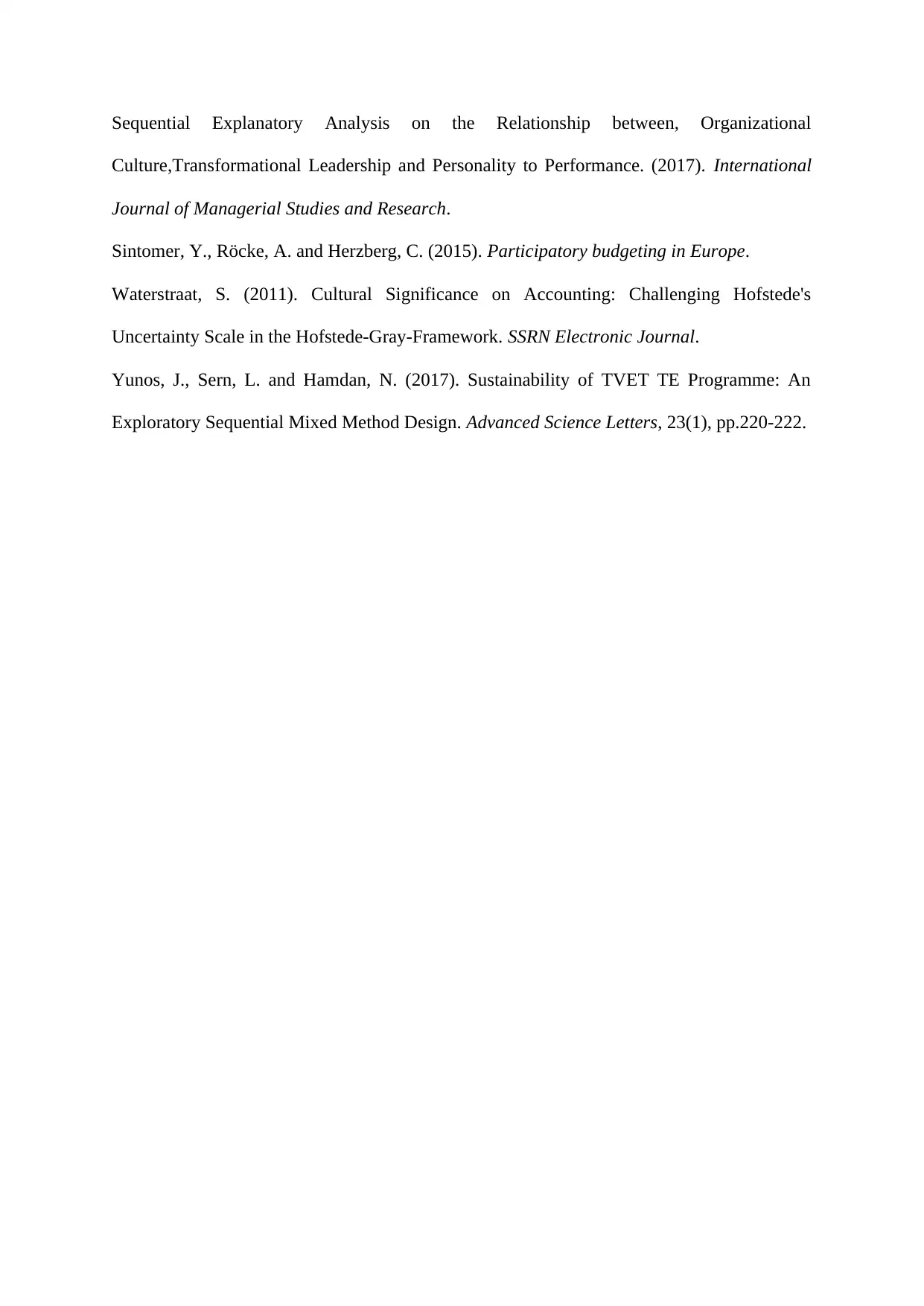
Sequential Explanatory Analysis on the Relationship between, Organizational
Culture,Transformational Leadership and Personality to Performance. (2017). International
Journal of Managerial Studies and Research.
Sintomer, Y., Röcke, A. and Herzberg, C. (2015). Participatory budgeting in Europe.
Waterstraat, S. (2011). Cultural Significance on Accounting: Challenging Hofstede's
Uncertainty Scale in the Hofstede-Gray-Framework. SSRN Electronic Journal.
Yunos, J., Sern, L. and Hamdan, N. (2017). Sustainability of TVET TE Programme: An
Exploratory Sequential Mixed Method Design. Advanced Science Letters, 23(1), pp.220-222.
Culture,Transformational Leadership and Personality to Performance. (2017). International
Journal of Managerial Studies and Research.
Sintomer, Y., Röcke, A. and Herzberg, C. (2015). Participatory budgeting in Europe.
Waterstraat, S. (2011). Cultural Significance on Accounting: Challenging Hofstede's
Uncertainty Scale in the Hofstede-Gray-Framework. SSRN Electronic Journal.
Yunos, J., Sern, L. and Hamdan, N. (2017). Sustainability of TVET TE Programme: An
Exploratory Sequential Mixed Method Design. Advanced Science Letters, 23(1), pp.220-222.
1 out of 14
Related Documents
Your All-in-One AI-Powered Toolkit for Academic Success.
+13062052269
info@desklib.com
Available 24*7 on WhatsApp / Email
![[object Object]](/_next/static/media/star-bottom.7253800d.svg)
Unlock your academic potential
© 2024 | Zucol Services PVT LTD | All rights reserved.





